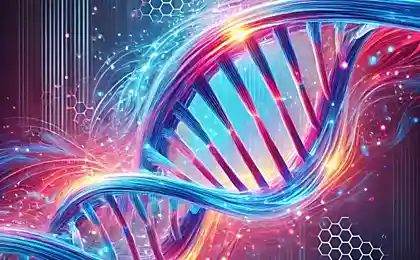568
How genes determine our behavior
At all times raised a philosophical question about free will. Someone from thinkers believed that people make decisions on their own; others have argued that everything in the world is predetermined, and the human will is an illusion. Modern studies of the human brain and its behavior has returned to the old dispute the relevance
Forty one million seven hundred thirty one thousand nine hundred nineteen
Brain, cell, gene
Sometimes we become hostages of their brain, as we often remind neuroscientists: for example, a patient with obsessive-compulsive disorder (OCD) suffer from persistent urge to hand wash due to the increased activity of the caudate nucleus. This part of the brain triggers signals in orbitofrontal cortex and makes a man commit senseless, at first glance, the action. These actions do not make sense only to the outside observer; the patient with OCD to cope with the anxiety that plagues him. Now OCD can be successfully treated with antidepressants, in particular, clomipraminum.
Psychologists investigating cognitive bias and the influence of external factors on the choice of the person, add fuel to the fire. It turns out that the music being played in the supermarket affects what kind of wine we buy. Faced with these peculiarities of our brain, we can ask ourselves the question: is man the master of himself? What is our life if not the result of a dice game, which amuse the different parts of the brain? It turns out that the activities of one or more cells may depend on the adoption of important for our life decisions. Perhaps the question should be reformulated, because the structure and activity of cells in the human brain depend on small, but very important elements, genes involved in the formation and functioning of the brain.
As you know, genes are the nucleotide sequence is deoxyribonucleic acid (DNA). DNA encodes the long strand of protein based on rule three nucleotides to one amino acid.
Replacement of one nucleotide with another is called a single nucleotide polymorphism (Single Nucleotide Portmanteau, SNP, SNiP), and can lead to a change in the protein sequence. For example, if a codon of threonine to change the first nucleotide, instead, the protein molecule will be a alanine. As a result, will change function of the protein: when the replaced amino acid was the active centre of the enzyme, it will cease to perform its function. This may lead to the death of cells and the whole organism. What will happen if change is not an enzyme, and receptor for the neurotransmitter in the brain? In this case, the replacement of one nucleotide may result in the difference in reaction between the neurotransmitter and the receptor. This is so easy to see, but we will see how it will affect the personality and affect human behavior.
Receptors based onOne of the main neurotransmitters in the Central nervous system is dopamine. Dopamine regulates the way muscles work (reduce tone and facilitate motor activity), entering in the extrapyramidal path. When disturbed the work of dopamine in the Central nervous system develop Parkinson's disease.
Neural structures, functioning on the basis of dopamine, are responsible for the formation of desires, purposeful activity and emotional perception, i.e. shape the behavior and personality of the person. One of the theories of schizophrenia is called dopamine and directly connects the violation of the metabolism of this substance in the nervous system with symptoms of the disease. In schizophrenia patients are often passive and show little emotion that can be caused by a deficiency of dopamine in certain parts of the brain.
Themselves to dopamine receptors* there are five types: from D1 to D5. Their coding genes are called respectively — DRD1, DRD2, and so on. The researchers bring together the receptors 1-GOI 5-type in the same group, and other receptors in another. This is due to the fact that the activation receptor of the first group in the cell increases the concentration of cyclic adenosine monophosphate (camp), which transmits the signal from the cell surface and activates enzyme systems.
In the interaction of receptors of the second group with the dopamine concentration of camp is reduced with consequences. The receptors of the 1st and 2nd type are the most common in the nervous system, and their polymorphism can influence our behavior through their multiplicity.
Enough chances to affect human behavior have receptors for dopamine of the 3rd and 4th types. They have it can happen not because of quantity but because of the specificity of the location. These receptors are found on neurons located in the reward system, the amygdala, the hippocampus and the cortex in those departments that directly affect our behavior. (Schematically, the remuneration system is shown in Fig. 1.)
* For the study of these receptors, belonging to the class of G-beloxepin, in 2012, awarded the Nobel prize in chemistry: "the Nobel prize in chemistry (2012): the buds of our first, third and fourth senses" — Ed.
Eighty one million nine hundred seventeen thousand two hundred thirty one
Figure 1. The reward system (it — system internal reinforcement) is a set of neural structures involved in the regulation and control of behavior by means of positive reactions to the actions. The picture shows the mesolimbic tract, which plays a significant role in the mechanisms of memory, emotions, learning, and neuroendocrine regulation. It is considered to be important in producing feelings of pleasure.Picture: Wikipedia.
There are many studies pointing to the relationship of gene polymorphism of receptor for dopamine with the clinical course of alcohol or drug dependence (see, for example, "the Word of the genetics of behavior"). Needless to say, narcologists and psychiatrists not associated with the development of addiction as a disease only genes: people are much more difficult, and his choice could affect close to the environment, and social conditions, and read at your leisure book. Genes affect the likelihood of certain events, giving the clinical picture based on more subtle shades.
For example, Chinese researchers have discovered that a longer time from first opioid use to the development of addiction is associated with two substitutions in the gene DRD1.
It is interesting that, apparently, different genes of the dopamine system "spetsializiruyutsya" in different dependencies: polymorphism генаDRD3 has no influence on the course of alcoholism .
Another dependency can be called sugar cravings. The replacement of the nucleotide in the gene DRD2 influences the amount of consumed sugar [7]. (The scheme of location of DRD2 gene on the 11th chromosome is shown in Fig. Two)
Researchers from Toronto studied more than 300 people of both sexes: the subjects filled out a questionnaire on frequency of use of various types of food, and their DNA was checked for the C957T polymorphism in the DRD2 gene.
It turned out that representatives of the fairer and stronger sex the same gene variants responsible for different feeding behavior. The polymorphism, which is associated with the lowest level of sugar consumption in women, led to the greatest amount of consumed glucose in men. It is noteworthy that the effect of the DRD2 gene did not extend to proteins and fats.
Twenty three million one hundred thirteen thousand four hundred seventy
Figure 2. The scheme of location of DRD2 gene on 11-chromosome.
Tangled threads
Dopamine receptor genes have significant correlation with the search for new and risk, and one risk behaviour is unprotected sex. The study, which lasted 8 years, it was revealed that a certain variant of the gene DRD2 leads to the fact that teenagers often have sex without using contraception. As clinical dependence, genes are only one factor influencing the use of contraception by adolescents. Along with genes, such factors include age (younger adolescents less likely to use contraception) and belonging to a national minority (the members of such groups less likely to use protection) [8].
However, the most studied in relation to effects on the behavior of the dopamine receptor gene DRD4 is. It is sometimes called the adventure gene, but this gene may have other names. One of the sections of the DRD4 gene, encoding a sequence of 16 amino acids (exon 3), can be repeated several times — from 2 to 11 (see Fig. 3). This difference, apparently, affects the quality of communication of the receptor with the molecule dopamine: more long-term options react to the neurotransmitter worse than "short".
The holders of the DRD4 gene with a sevenfold repetition of the exon are more reactive. [9]. People are more altruistic, if their genotype there is a sevenfold repetition of this phase [10]. These repetitions also affect the age of acquisition of first sexual experience [11], and a sevenfold repetition of the referenced sequence is associated with the highest susceptibility of the child to external conditions.
Sixty five million seven hundred ninety thousand one hundred seventy four
Figure 3. Repetitive elements in the gene DRD4.
It is obvious that people's behavior is determined not only by genes, but also environment. In 2010 year, the Greek scientists have studied the gambling behavior of men who have four - and seven-fold repeats in exon 3, with regard to the season of their birth.
It turned out that the worst of all gambling to be "winter" men with seven repeats of exon 3. This interaction "gene-environment" described by Alexander Markov in one of the articles for the portal Elements.
Researchers at the University of California on a sample of two and a half thousand people showed that the allelic variant of the DRD4 seven-repeat exon III leads to the formation of the liberal political views of those carriers, which also had a large number of friends in childhood. In people without seven-time repeat number of friends had no influence on the formation of political views.
Now, scientists are only beginning to understand the genetics of behavior, but this science has important practical implications. People with certain variants of dopamine genes are at risk for disruptions in the painful dependencies. It is possible that in the future during the initial admission to a drug treatment clinic patients will undergo analysis to identify such genes, and the programme of treatment will be made in accordance with the genotype.
The situation becomes more complicated due to the fact that the genes that control our behavior, can be extremely a lot, and while it is impossible to trace the influence of each of them for us. Moreover, their effects are evident at the level of the statistics mentioned in the article gene variants probably increase or decrease the likelihood of certain types of behavior and not strictly to write them into our personality. We should not overestimate the influence of the environment: whose "risk genes" may show itself not in the passion of extreme sports and active social activities.
So, even if we assume that free will is an illusion and our behavior is determined by genes and stimuli of the external environment, the number of invisible control thread, stretching to the puppet, so great, and they are so confused that it is almost impossible to predict how the doll behaves. It is this indescribable complexity of human behavior and its unpredictability is what we call free will. published
Author: Viktor Lebedev
Literature:biomolecule: "a brief history of antidepressants";
biomolecule: "At the origins of the genetic code: kindred souls";
biomolecule: "the Nobel prize in chemistry (2012): the buds of our first, third and fourth senses";
biomolecule: "the Word about the genetics of behavior";
Zhu F., Yan C.-H., Wen Y.-C., Wang J., Bi, J., Zhao, Y. L., Wei L., Gao C.-G., Jia W., Li S.-B. (2013). Dopamine D1 Receptor Gene Variation Modulates Opioid Dependence Risk by Affecting Transition to Addiction. PLoS One 8, e70805;
P. Gorwood, F. Limosin, P. Batel, Duaux E., Gouya L., Adès J. (2001). The genetics of addiction: alcohol-dependence and D3 dopamine receptor gene. Path. Biol. 49, 710-717;
Eny K. M., Corey P. N., El-Sohemy A. (2009). Dopamine D2 receptor genotype (C957T) and habitual consumption of sugars in a free-living population of men and women. J. Nutr. Nutrigenomics 2,235–242;
Dawa J., Guoa, G. (2011). The influence of three genes on whether adolescents use contraception, USA 1994-2002. J. Demogr. 65, 253-271;
Forbes, E. E., Shaw D. S., Dahl, R. E. (2007). Alterations in reward-related decision making in boys with recent and future depression. Biol. Psych. 61, 633-639;
Jiang Y., Chew S. H., Ebstein, R. P. (2013). The role of D4 receptor gene exon III polymorphisms in shaping human altruism and prosocial behavior. Front. Hum. Neurosci. 7, 195;
Guo, G., Tong Y. (2006). Age at first sexual intercourse, genes, and social context: evidence from twins and the dopamine D4 receptor gene. Demography 43, 747-769;
Roussos P., Giakoumaki S. G., Bitsios P. (2010). Cognitive and emotional processing associated with the Season of Birth and dopamine D4 receptor gene. Neuropsychol. 48, 3926-3933;
Elements: "Political views depend not only on genes but also on the amount of friends".
Source: biomolecula.ru/content/1464
Forty one million seven hundred thirty one thousand nine hundred nineteen
Brain, cell, gene
Sometimes we become hostages of their brain, as we often remind neuroscientists: for example, a patient with obsessive-compulsive disorder (OCD) suffer from persistent urge to hand wash due to the increased activity of the caudate nucleus. This part of the brain triggers signals in orbitofrontal cortex and makes a man commit senseless, at first glance, the action. These actions do not make sense only to the outside observer; the patient with OCD to cope with the anxiety that plagues him. Now OCD can be successfully treated with antidepressants, in particular, clomipraminum.
Psychologists investigating cognitive bias and the influence of external factors on the choice of the person, add fuel to the fire. It turns out that the music being played in the supermarket affects what kind of wine we buy. Faced with these peculiarities of our brain, we can ask ourselves the question: is man the master of himself? What is our life if not the result of a dice game, which amuse the different parts of the brain? It turns out that the activities of one or more cells may depend on the adoption of important for our life decisions. Perhaps the question should be reformulated, because the structure and activity of cells in the human brain depend on small, but very important elements, genes involved in the formation and functioning of the brain.
As you know, genes are the nucleotide sequence is deoxyribonucleic acid (DNA). DNA encodes the long strand of protein based on rule three nucleotides to one amino acid.
Replacement of one nucleotide with another is called a single nucleotide polymorphism (Single Nucleotide Portmanteau, SNP, SNiP), and can lead to a change in the protein sequence. For example, if a codon of threonine to change the first nucleotide, instead, the protein molecule will be a alanine. As a result, will change function of the protein: when the replaced amino acid was the active centre of the enzyme, it will cease to perform its function. This may lead to the death of cells and the whole organism. What will happen if change is not an enzyme, and receptor for the neurotransmitter in the brain? In this case, the replacement of one nucleotide may result in the difference in reaction between the neurotransmitter and the receptor. This is so easy to see, but we will see how it will affect the personality and affect human behavior.
Receptors based onOne of the main neurotransmitters in the Central nervous system is dopamine. Dopamine regulates the way muscles work (reduce tone and facilitate motor activity), entering in the extrapyramidal path. When disturbed the work of dopamine in the Central nervous system develop Parkinson's disease.
Neural structures, functioning on the basis of dopamine, are responsible for the formation of desires, purposeful activity and emotional perception, i.e. shape the behavior and personality of the person. One of the theories of schizophrenia is called dopamine and directly connects the violation of the metabolism of this substance in the nervous system with symptoms of the disease. In schizophrenia patients are often passive and show little emotion that can be caused by a deficiency of dopamine in certain parts of the brain.
Themselves to dopamine receptors* there are five types: from D1 to D5. Their coding genes are called respectively — DRD1, DRD2, and so on. The researchers bring together the receptors 1-GOI 5-type in the same group, and other receptors in another. This is due to the fact that the activation receptor of the first group in the cell increases the concentration of cyclic adenosine monophosphate (camp), which transmits the signal from the cell surface and activates enzyme systems.
In the interaction of receptors of the second group with the dopamine concentration of camp is reduced with consequences. The receptors of the 1st and 2nd type are the most common in the nervous system, and their polymorphism can influence our behavior through their multiplicity.
Enough chances to affect human behavior have receptors for dopamine of the 3rd and 4th types. They have it can happen not because of quantity but because of the specificity of the location. These receptors are found on neurons located in the reward system, the amygdala, the hippocampus and the cortex in those departments that directly affect our behavior. (Schematically, the remuneration system is shown in Fig. 1.)
* For the study of these receptors, belonging to the class of G-beloxepin, in 2012, awarded the Nobel prize in chemistry: "the Nobel prize in chemistry (2012): the buds of our first, third and fourth senses" — Ed.
Eighty one million nine hundred seventeen thousand two hundred thirty one
Figure 1. The reward system (it — system internal reinforcement) is a set of neural structures involved in the regulation and control of behavior by means of positive reactions to the actions. The picture shows the mesolimbic tract, which plays a significant role in the mechanisms of memory, emotions, learning, and neuroendocrine regulation. It is considered to be important in producing feelings of pleasure.Picture: Wikipedia.
There are many studies pointing to the relationship of gene polymorphism of receptor for dopamine with the clinical course of alcohol or drug dependence (see, for example, "the Word of the genetics of behavior"). Needless to say, narcologists and psychiatrists not associated with the development of addiction as a disease only genes: people are much more difficult, and his choice could affect close to the environment, and social conditions, and read at your leisure book. Genes affect the likelihood of certain events, giving the clinical picture based on more subtle shades.
For example, Chinese researchers have discovered that a longer time from first opioid use to the development of addiction is associated with two substitutions in the gene DRD1.
It is interesting that, apparently, different genes of the dopamine system "spetsializiruyutsya" in different dependencies: polymorphism генаDRD3 has no influence on the course of alcoholism .
Another dependency can be called sugar cravings. The replacement of the nucleotide in the gene DRD2 influences the amount of consumed sugar [7]. (The scheme of location of DRD2 gene on the 11th chromosome is shown in Fig. Two)
Researchers from Toronto studied more than 300 people of both sexes: the subjects filled out a questionnaire on frequency of use of various types of food, and their DNA was checked for the C957T polymorphism in the DRD2 gene.
It turned out that representatives of the fairer and stronger sex the same gene variants responsible for different feeding behavior. The polymorphism, which is associated with the lowest level of sugar consumption in women, led to the greatest amount of consumed glucose in men. It is noteworthy that the effect of the DRD2 gene did not extend to proteins and fats.
Twenty three million one hundred thirteen thousand four hundred seventy
Figure 2. The scheme of location of DRD2 gene on 11-chromosome.
Tangled threads
Dopamine receptor genes have significant correlation with the search for new and risk, and one risk behaviour is unprotected sex. The study, which lasted 8 years, it was revealed that a certain variant of the gene DRD2 leads to the fact that teenagers often have sex without using contraception. As clinical dependence, genes are only one factor influencing the use of contraception by adolescents. Along with genes, such factors include age (younger adolescents less likely to use contraception) and belonging to a national minority (the members of such groups less likely to use protection) [8].
However, the most studied in relation to effects on the behavior of the dopamine receptor gene DRD4 is. It is sometimes called the adventure gene, but this gene may have other names. One of the sections of the DRD4 gene, encoding a sequence of 16 amino acids (exon 3), can be repeated several times — from 2 to 11 (see Fig. 3). This difference, apparently, affects the quality of communication of the receptor with the molecule dopamine: more long-term options react to the neurotransmitter worse than "short".
The holders of the DRD4 gene with a sevenfold repetition of the exon are more reactive. [9]. People are more altruistic, if their genotype there is a sevenfold repetition of this phase [10]. These repetitions also affect the age of acquisition of first sexual experience [11], and a sevenfold repetition of the referenced sequence is associated with the highest susceptibility of the child to external conditions.
Sixty five million seven hundred ninety thousand one hundred seventy four
Figure 3. Repetitive elements in the gene DRD4.
It is obvious that people's behavior is determined not only by genes, but also environment. In 2010 year, the Greek scientists have studied the gambling behavior of men who have four - and seven-fold repeats in exon 3, with regard to the season of their birth.
It turned out that the worst of all gambling to be "winter" men with seven repeats of exon 3. This interaction "gene-environment" described by Alexander Markov in one of the articles for the portal Elements.
Researchers at the University of California on a sample of two and a half thousand people showed that the allelic variant of the DRD4 seven-repeat exon III leads to the formation of the liberal political views of those carriers, which also had a large number of friends in childhood. In people without seven-time repeat number of friends had no influence on the formation of political views.
Now, scientists are only beginning to understand the genetics of behavior, but this science has important practical implications. People with certain variants of dopamine genes are at risk for disruptions in the painful dependencies. It is possible that in the future during the initial admission to a drug treatment clinic patients will undergo analysis to identify such genes, and the programme of treatment will be made in accordance with the genotype.
The situation becomes more complicated due to the fact that the genes that control our behavior, can be extremely a lot, and while it is impossible to trace the influence of each of them for us. Moreover, their effects are evident at the level of the statistics mentioned in the article gene variants probably increase or decrease the likelihood of certain types of behavior and not strictly to write them into our personality. We should not overestimate the influence of the environment: whose "risk genes" may show itself not in the passion of extreme sports and active social activities.
So, even if we assume that free will is an illusion and our behavior is determined by genes and stimuli of the external environment, the number of invisible control thread, stretching to the puppet, so great, and they are so confused that it is almost impossible to predict how the doll behaves. It is this indescribable complexity of human behavior and its unpredictability is what we call free will. published
Author: Viktor Lebedev
Literature:biomolecule: "a brief history of antidepressants";
biomolecule: "At the origins of the genetic code: kindred souls";
biomolecule: "the Nobel prize in chemistry (2012): the buds of our first, third and fourth senses";
biomolecule: "the Word about the genetics of behavior";
Zhu F., Yan C.-H., Wen Y.-C., Wang J., Bi, J., Zhao, Y. L., Wei L., Gao C.-G., Jia W., Li S.-B. (2013). Dopamine D1 Receptor Gene Variation Modulates Opioid Dependence Risk by Affecting Transition to Addiction. PLoS One 8, e70805;
P. Gorwood, F. Limosin, P. Batel, Duaux E., Gouya L., Adès J. (2001). The genetics of addiction: alcohol-dependence and D3 dopamine receptor gene. Path. Biol. 49, 710-717;
Eny K. M., Corey P. N., El-Sohemy A. (2009). Dopamine D2 receptor genotype (C957T) and habitual consumption of sugars in a free-living population of men and women. J. Nutr. Nutrigenomics 2,235–242;
Dawa J., Guoa, G. (2011). The influence of three genes on whether adolescents use contraception, USA 1994-2002. J. Demogr. 65, 253-271;
Forbes, E. E., Shaw D. S., Dahl, R. E. (2007). Alterations in reward-related decision making in boys with recent and future depression. Biol. Psych. 61, 633-639;
Jiang Y., Chew S. H., Ebstein, R. P. (2013). The role of D4 receptor gene exon III polymorphisms in shaping human altruism and prosocial behavior. Front. Hum. Neurosci. 7, 195;
Guo, G., Tong Y. (2006). Age at first sexual intercourse, genes, and social context: evidence from twins and the dopamine D4 receptor gene. Demography 43, 747-769;
Roussos P., Giakoumaki S. G., Bitsios P. (2010). Cognitive and emotional processing associated with the Season of Birth and dopamine D4 receptor gene. Neuropsychol. 48, 3926-3933;
Elements: "Political views depend not only on genes but also on the amount of friends".
Source: biomolecula.ru/content/1464























